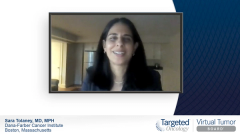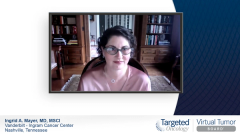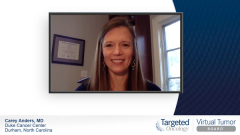
Case 1: High-Risk HER2+ Early-Stage Breast Cancer
Andrew Seidman, MD, reviews the case of a 45-year-old woman with HER2+ breast cancer, and the panel discusses initial treatment.
Episodes in this series

Sara Tolaney, MD, MPH:Thank you for joining us for this Targeted Oncology™ Virtual Tumor Board® focused on advanced HER2+ [human epidermal growth factor receptor 2–positive] breast cancer. In today’s presentation, my colleagues and I will review 3 clinical cases. We’ll discuss an individualized approach to treatment for each patient and review key clinical data that impacts these decisions. My name is Sara Tolaney, and I’m a breast medical oncologist at Dana-Farber Cancer Institute in Boston, Massachusetts. I’m lucky to be joined by my esteemed colleagues, Dr Carey Anders from Duke Cancer Center in Durham, North Carolina; Dr Ingrid Mayer from Vanderbilt-Ingram Cancer Center in Nashville, Tennessee; and Dr Andrew Seidman from Memorial Sloan Kettering Cancer Center in New York, New York. Let’s get started. We’ll turn to Andy to present our first case, which is focused on high risk HER2+ breast cancer in the early stage setting.
Andrew Seidman, MD: Thank you, Sara. The first case we’re going to consider is a 45-year-old woman who presented with a palpable mass in the left breast as well as an enlarged ipsilateral left axillary lymph node. Breast imaging—both mammography ultrasound—revealed a 4.1-cm mass as well as ipsilateral enlarged axillary lymph node. And a breast MRI also confirmed about a 4-cm lesion in the close to 12 o’clock position in the upper-outer quadrant. A core needle biopsy of this breast mass revealed a grade 3 invasive ductal carcinoma that was negative for hormone receptors and positive for HER2 by immunohistochemistry as well as by FISH [fluorescence in situ hybridization]. We’re also told that a fine-needle aspiration of the axillary node was positive for malignant cells. This is a clinical T2, N1, M0 stage IIB breast cancer in a 45-year-old woman. She is ER [estrogen receptor]– and PR [progesterone receptor]–negative and HER2+.
Sara Tolaney, MD, MPH: When you come across this kind of a patient in clinic, who has a tumor that’s over 2 cm with nodal involvement, how are you approaching this patient in terms of either systemic therapy up front or potentially moving to surgery first? How do you make that treatment decision?
Andrew Seidman, MD: This patient certainly meets criteria for consideration for dual HER2-targeted therapy with both trastuzumab and pertuzumab in the neoadjuvant setting. That is my favorite approach for a few reasons. One, there is the potential to downstage the primary and possibly offer breast-conserving surgery with a good cosmetic result if it wouldn’t be likely otherwise. There is the potential for downstaging the axilla and limiting axillary surgery. Then of course there’s the information that one gains from the pathological response to decide about optimal adjuvant therapy.
Sara Tolaney, MD, MPH: It’s interesting how key giving preoperative therapy has become. We’ve learned how to potentially gain information from doing this in the preop setting. I fully agree that this is quite critical and should be standard of care in someone who has either nodal involvement or a tumor over 2 cm.
Ingrid A. Mayer, MD, MSCI: Aside from everything you said, the biggest value that we get is by doing neoadjuvant treatment in addition to all this. This is true for triple-negative cases as well as the predictive ability of that residual cancer burden telling you, “Does this patient need more treatment, or can we stop here, and they’ll do well long term?” It’s not just the prognostic ability but also being able to tailor more treatment or not based on past CR [complete response] or absence of past CR. It changes practice. It goes beyond just the curiosities you’re going to do well. It changes what you do.
Sara Tolaney, MD, MPH: We’ve learned we can adapt this post-preoperative treatment based on response to change outcome, which is a tremendous learning for us and making this critical to do. When you’re thinking about how you want to treat someone in the preoperative setting, Andy mentioned he would use dual HER2-directed therapy here. How about anthracycline treatment? How are you deciding on chemotherapy choice for someone like this? This is a node positive, hormone receptor negative, HER2-positive patient. Carey, we can turn to you. What are you doing for chemotherapy choice here?
Carey Anders, MD:In this case it is, it’s not overly controversial to use a neoadjuvant approach. We have a large tumor, a positive lymph node. I agree with everything that was said before. It becomes trickier when it’s around 2 cm and the lymph nodes may be inconclusive. That’s a balanced discussion with the patient about everything we’ve just discussed about optimizing therapy even postoperatively. Preoperatively I have relied on the TCHP [docetaxel, trastuzumab, pertuzumab, carboplatin] regimen. We’ve known for quite some time and evaluated the benefit of anthracycline and HER2+ breast cancer in several studies dating to the BCRG [Breast Cancer Research Group]. The more recent TRAIN-2 data has solidified that decision in my mind. That was 3 cycles of anthracycline-trastuzumab-pertuzumab, followed by 6 cycles of taxane with trastuzumab-pertuzumab. The 1 caveat with that study is that the comparator arm was 9 cycles of TCHP [docetaxel, trastuzumab, pertuzumab, carboplatin], and that’s a lot of preoperative therapy. In that study there was no significant difference and outcome between the 2 groups from a longer-term outcome perspective. I was comfortable offering the TCHP [docetaxel, trastuzumab, pertuzumab, carboplatin] regimen preoperatively without an anthracycline. I have continued with 6 cycles. I’m curious to hear what my copanelists would say about that.
Andrew Seidman, MD: Can I ask you to clarify TCHP [docetaxel, trastuzumab, pertuzumab, carboplatin]? Because what TRAIN-2 told us—compared with TRYPHAENA, for example—is that if weekly paclitaxel is your T, so to speak, the toxicity profile is different from docetaxel as your weekly taxane.
Carey Anders, MD: That’s a very good point. I have traditionally used the docetaxel-carboplatin-trastuzumab-pertuzumab regimen every 3 weeks with growth factor support for 6 cycles. Have you transitioned to the weekly taxane?
Andrew Seidman, MD: My default regimen is typically dose-dense AC [doxorubicin, cyclophosphamide], followed by weekly paclitaxel times 12 with HP [trastuzumab, pertuzumab] concurrently. TRAIN did show equivalent efficacy if you omit FEC [5-fluorouracil, epirubicin, cyclophosphamide] for 3 cycles and substitute with weekly paclitaxel and carboplatin. And there was a 10% rate of febrile neutropenia with the FEC [5-fluorouracil, epirubicin, cyclophosphamide] sequential regimen. Some of you may remember Dr Sandy Swain published the BERENICE trial a couple of years ago in Annals of Oncology. It compared dose-dense AC [doxorubicin, cyclophosphamide] with weekly paclitaxel HP [trastuzumab, pertuzumab] with the FEC [5-fluorouracil, epirubicin, cyclophosphamide]–docetaxel backbone. There was more febrile neutropenia than you’re going to see when you give anthracycline. It was 7% in BERENICE, and there will be a greater proportion of patients who have LV [left ventricular] dysfunction. I haven’t abandoned anthracycline in the preoperative setting, and for a 45-year-old woman with a healthy heart, like in this case, that would certainly be on the table for me.
Transcript edited for clarity.










































